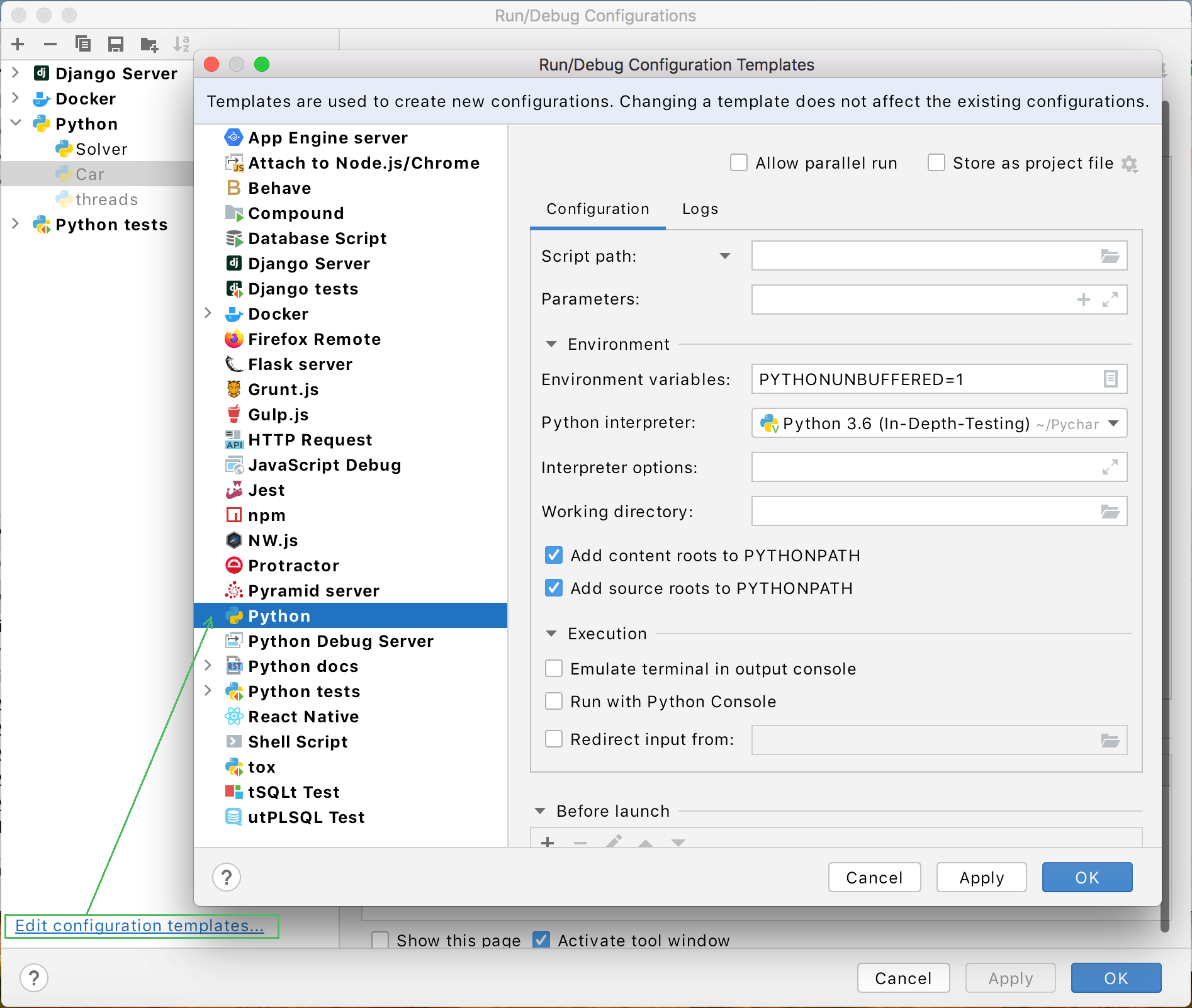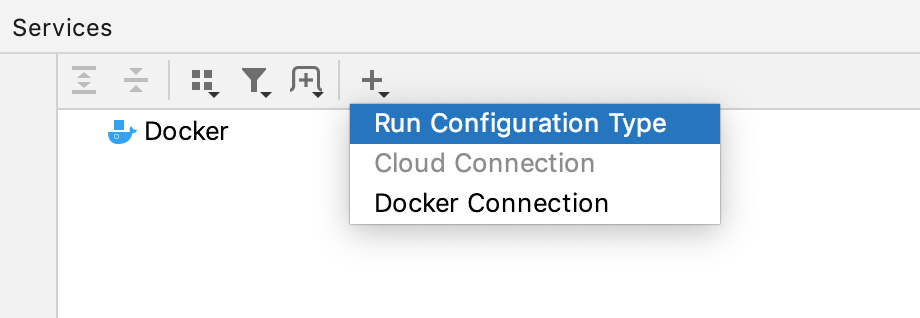Configuration Is Still Incorrect Do You Want to Edit It Again Pycharm
Run/debug configurations
PyCharm uses run/debug configurations to run, debug, and test your lawmaking. Each configuration is a named set of startup backdrop that ascertain what to execute and what parameters and environs should exist used.
With dissimilar startup properties, you tin can define different ways that PyCharm uses to execute your script. For example, you can execute the same code with different Python interpreters, providing various sets of environment variables, and getting input values from alternative files.
There are two types of run/debug configurations:
-
Temporary — created every time yous run or debug functions or tests.
-
Permanent — created explicitly from a template or by saving a temporary configuration. Permanent configurations remain as part of your project until yous remove them.
So whenever y'all run/debug or exam your code, PyCharm either uses an existing permanent run/debug configuration or creates a new temporary ane.
Permanent configurations have opaque icons while the icons of temporary configurations are semi-transparent.
The maximum number of temporary configurations is 5. The older ones are automatically deleted when new ones are added. If necessary, you can increase this limit in .
Create permanent run/debug configurations
PyCharm provides the following ways to create a permanent run/debug configuration:
-
Save a temporary run/debug configuration equally permanent.
-
Create from a template or re-create an existing configuration.
Relieve a temporary configuration equally permanent
-
Select a temporary configuration in the run/debug configuration switcher and then click Salve Configuration.
Once you save a temporary configuration, it becomes permanent and it is recorded in a separate XML file in the <projection directory>/.idea/ directory. For example, MyProject/.idea/Car.xml.
-
Alternatively, select a temporary configuration in the Run/debug configurations dialog and click
on the toolbar.
PyCharm provides run/debug configuration templates for different languages, tools, and frameworks. The list of bachelor templates varies depending on the installed and enabled plugins.
Create a run/debug configuration from a template
-
From the main carte, select . Alternatively, press Alt+Shift+F10, then 0.
-
In the Run/Debug Configuration dialog, click
on the toolbar or press Alt+Insert. The list shows the run/debug configuration templates.
Select the desired template. If you are not sure which template to choose, refer to Run/debug configurations dialog for more information on detail templates.

-
Specify the run/debug configuration name in the Name field. This name will be shown in the list of the available run/debug configurations.
-
Select Allow parallel run if you want to allow multiple instances of the configuration to run at the same time. If this option is disabled, attempting to re-run the configuration volition cease the active session.
-
Set the run/debug configuration parameters.
-
In the Before launch department, define whether yous want to perform any specific actions earlier launching the application, for instance, execute some tools or scripts prior to launching the run/debug configuration.
For information on particular Before launch activities, refer to Before launch
-
Apply the changes and close the dialog.
If y'all are working in a squad, you might want to share your run/debug configurations then that your teammates could run the application using the same configuration or enable them to remotely attach to the process you are running.
For these purposes, PyCharm provides a mechanism to shop your run/debug configurations equally project files and share them through VCS. The aforementioned machinery can as well be used when you want to send your configuration as a file to someone else. This saves a lot of time as run/debug configurations sometimes become sophisticated, and keeping them in sync manually would be tedious and error-prone.
-
From the main bill of fare, select . Alternatively, press Alt+Shift+F10, so 0.
-
Select the run/debug configuration you lot desire to share, enable the Store equally projection file pick, and specify the location where the configuration file will be stored.
If compatibility with PyCharm 2019.3 and earlier is required, store the file in the default location.
-
(Optional) If the .idea directory is added to VCS ignored files, the .idea/runConfigurations subfolder will exist ignored, likewise. If you use Git for your project, you lot can share .idea/runConfigurations only and go out .idea ignored by modifying .gitignore as follows:
/.thought/* !/.idea/runConfigurations
Run/debug configuration templates
All run/debug configurations are based on templates, which implement the startup logic, define the listing of parameters and their default values. The list of available templates is predefined in the installation and tin can only exist extended via plugins. Yet, you tin edit default parameter values in each template to streamline the setup of new run/debug configurations.
Configure the default values for a template
-
From the principal menu, select . Alternatively, press Alt+Shift+F10, then 0.
-
In the left-hand pane of the run/debug configuration dialog, click Edit configuration templates….
-
In the Run/Debug Configuration Templates dialog that opens, select a configuration blazon.

-
Specify the desired default parameters and click OK to save the template.
Compound run/debug configurations
Suppose you would like to launch multiple run/debug configurations simultaneously. For example, you may want to run several configurations of dissimilar types or a grouping of test configurations. You tin can configure this behavior with a compound run/debug configuration.
Create a compound run/debug configuration
-
From the main menu, select . Alternatively, press Alt+Shift+F10, and then 0.
-
In the Run/Debug Configurations dialog, click
or press Alt+Insert, so select Compound.
-
Specify the run/debug configuration proper name in the Proper name field. This name will be shown in the list of the available run/debug configurations.
-
Select Store as project file to brand this run/debug configuration available to other team members.
-
To include a new run/debug configuration into the chemical compound configuration , click Add
and select the desired one from the listing.
-
Use the changes.
Run/debug configuration folders
When there are many run/debug configurations of the same type, you can group them in folders and so they become easier to distinguish visually.
One time grouped, the run/debug configurations appear in the listing under the corresponding folders.

Create a binder for run/debug configurations
-
From the main menu, select . Alternatively, press Alt+Shift+F10, and so 0.
-
In the Run/Debug Configurations dialog, select a configuration blazon and click
on the toolbar. A new empty folder for the selected type is created.
-
Specify the folder proper noun in the text field to the right or accept the default proper noun.
-
Select the desired run/debug configurations and move them nether the target binder.
-
Utilise the changes. If a folder is empty, information technology will non be saved.
When you no longer need a folder, yous can delete information technology Delete. The run/debug configurations grouped under this folder will be moved under the root of the corresponding run/debug configuration blazon.
Y'all can manage multiple run/debug configurations in the Services tool window. For example, you can first, pause, and terminate several applications, track their condition, and examine application-specific details.
Add Run/Debug configurations to the Services window
-
Select from the main menu or press Alt+8.
-
In the Services tool window, click Add together service, so select Run Configuration Blazon.

-
Select a run/debug configuration blazon from the list to add together all configurations of this type to the window.
Note that the tool window will only display the configuration types for which y'all have created one or more configurations.
Run/Debug configuration parameters
| Detail | Description | ||||||||
|---|---|---|---|---|---|---|---|---|---|
| Script path/Module name | Click the list to select a type of target to run. So, in the corresponding field, specify the path to the Python script or the module proper name to be executed. | ||||||||
| Parameters | In this field, specify parameters to be passed to the Python script. When specifying the script parameters, follow these rules:
In this field you tin add a macros to pass various projection- or context-specific values when running a run/debug configuration. Click + and select ane of the available macros from the listing. Run across Calculation macros to run/debug configuration for more than details. | ||||||||
| Surround | |||||||||
| Project | Click this listing to select one of the projects, opened in the same PyCharm window, where this run/debug configuration should exist used. If in that location is but one open projection, this field is non displayed. | ||||||||
| Environs variables | This field shows the list of surroundings variables. If the list contains several variables, they are delimited with semicolons. Past default, the field contains the variable To create a new variable, click You might want to populate the list with the variables stored equally a series of records in a text file, for instance: Variable1 = Value1 Variable2 = Value2 Just copy the list of variables from the text file and click Paste ( | ||||||||
| Python Interpreter | Select one of the pre-configured Python interpreters from the list. | ||||||||
| Interpreter options | In this field, specify the command-line options to exist passed to the interpreter. If necessary, click | ||||||||
| Working directory | Specify a directory to exist used by the running task.
| ||||||||
| Add together content roots to PYTHONPATH | Select this checkbox to add together all content roots of your project to the environment variable PYTHONPATH; | ||||||||
| Add source roots to PYTHONPATH | Select this checkbox to add all source roots of your project to the surroundings variable PYTHONPATH; | ||||||||
| Execution | |||||||||
| Emulate terminal in output console | Enables running your script or module in the output console with the emulated terminal style. This manner can be helpful for the tasks that cannot exist implemented with the standard output console, for case, when your script performs caret return deportment ( Note that emulating terminal in the output console differs from running the Last that is a separate tool window used for running organization shell commands. | ||||||||
| Run with Python panel | Enables running your script or module with the Python console. | ||||||||
| Redirect input from | Enables redirecting data from a text file to standard input. Utilise this option if your script requires some input and yous want to automatically submit the values instead of typing them in the Run console. To enable redirecting, select the checkbox and specify the path to the target text file. | ||||||||
| Docker container settings Click | |||||||||
| Options |
Click | ||||||||
| Docker Compose | |||||||||
| Commands and options | You tin can utilise the post-obit commands of the Docker Compose Command-Line Interface:
| ||||||||
| Command Preview | You can aggrandize this field to preview the complete control string. Instance: if you lot enter the following combination in the Commands and options field: the preview output should looks as follows: docker-compose -f C:\PyCharm-2019.2\Demos\djangodocker-principal\docker-compose.yml -f <override configuration file> up --build exec --user jetbrains | ||||||||
Last modified: 17 March 2022
Source: https://www.jetbrains.com/help/pycharm/run-debug-configuration.html
0 Response to "Configuration Is Still Incorrect Do You Want to Edit It Again Pycharm"
Post a Comment